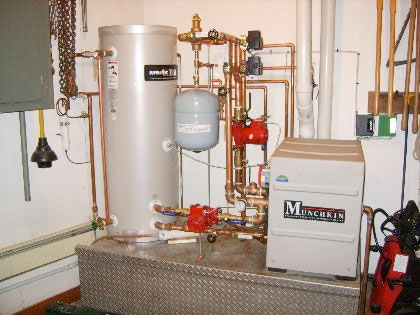Need advice on cost effective but reliable equipment. Leaning toward a gas boiler and storage tank options. (Indoor pool, basement equipment room. Distance to venting outside is less than 20 feet but existing pipes are 3 inches.) any idea on approximate cost of project?
Blog Post
Using Your Heating System to Heat Water

Continuing our series on water heating, this week we'll look at two options for heating water with the home's central boiler. First some terminology: boilers heat water or produce steam for distribution in baseboard units or steam radiators, while furnaces heat air for distribution through ducts and registers. Integrating water heating with a standard hot-air furnace is not possible; if you have a furnace, you have to stick with a stand-alone water heater.
There's a lot of appeal to the idea of using your boiler to also heat water. You can get by with just one burner for both heat and hot water, so there's less to maintain or to go wrong, and when you're heating the house anyway, it doesn't take all that much extra energy to heat water also.
There are two common options for using a home's boiler for water heating. The most common is referred to as a "tankless coil." This is a relatively small heat exchanger that fits into a gas- or oil-fired boiler. These are popular for people with hot-water baseboard heat because they're inexpensive options or retrofits for standard boilers. A copper-coil heat exchanger extends into the boiler, and water is heated as it flows through this coil. It is very much like the "tankless water heater" described last week, except that the heat source is your boiler.
The problem with tankless-coil water heaters is that the boiler has to be hot to produce hot water. In the winter in a cold climate, the boiler is hot much of the time and may not even need to fire up to supply hot water (due to residual heat in the boiler). But during the summer the boiler is less likely to be hot, and the on-off cycling to heat water wastes a lot of energy. It is not unusual for water heating using an oil-fired boiler and tankless coil to use 200 to 300 gallons of oil during the summer months, and the average efficiency during that period may be as low as 25%. Thus, tankless-coil water heaters can make sense in the winter months, but they aren't a good idea in summer.
The other primary option for using a heating system to produce hot water is to install an "indirect" or "indirect-fired" water heater. This is a separate insulated water tank that is heated using hot water from the gas- or oil-fired boiler. The indirect tank is usually plumbed to be a separate "zone" on the heating system. One advantage of this option is that during the warmer months the boiler only has to fire up occasionally to heat water in the indirect tank. Because water in the tank remains "thermally stratified" (with the hot water at the top, where it is drawn off to supply your shower or dishwasher), you can draw hot water from the tank multiple times before the boiler turns on to heat water in the tank.
Another plus is that because there is no burner on the storage tank, you can wrap it with extra insulation without having to worry about an air supply or venting (as you do with a gas-fired, storage-type water heater).
SUPPORT INDEPENDENT SUSTAINABILITY REPORTING
BuildingGreen relies on our premium members, not on advertisers. Help make our work possible.
See membership options »The downside to indirect water heaters is the cost. A good one will likely cost over $1,000, including installation of the additional zone on the heating system. This is much more expensive than a tankless coil or a conventional gas or electric storage-type water heater.
Interestingly, both kinds of integrated water heaters can help to keep your boiler in good working order. If your boiler is in a basement that stays fairly damp during the summer months, having it fire periodically--as will occur with either a tankless-coil or indirect water heater--is recommended by many heating contractors as a way to minimize corrosion. That was one of the reasons we put in an indirect water heater when we installed a Buderus boiler at our home ten or twelve years ago. Otherwise, I would likely have stuck with the stand-alone electric water heater that we had operated using off-peak electricity prior to installing a central heating system (more on off-peak electric water heating in a future column).
Some people choose to use a tankless-coil water heater during the winter months and then switch over to a stand-alone electric or gas-fired water heater during the summer. Except for possible boiler corrosion problems in damp basements, this can be a good compromise. Ask your heating contractor or plumber for advice on these different options for your particular situation.
Published June 8, 2009 Permalink Citation
(2009, June 8). Using Your Heating System to Heat Water. Retrieved from https://www.buildinggreen.com/blog/using-your-heating-system-heat-water
Comments
Researching options
In 1978, on my own, I installed a N gas fired furnace and found and installed used cast iron baseboard radiators for hot water flow. I also installed a separate gas fired tanked water heater which I had to replace several times. I would like to find a single gas fired unit that will heat the house and give me on demand hot water for bath and ect. I don't know who makes a unit to meet these specs and would install it myself if it would consume less gas. It makes since to me that the hot water coils should be exposed to the same flames when the house heating system is on with maybe a pressure escape valve to the house heating master pipe. When house heating is off and one starts to draw bath water, the same burner should turn on maybe triggered by a drop in pressure in the hot water pipe. Are there any better options available? Is there a more efficient design out there? Please give me a brand name and model of a reliable unit. (edited)
Heating
Hi,
I was wondering how do I shut off the heater during the summer time? It looks I need to leave the heater on in order to have hot water, but the house gets SO hot during the summer time.
Thanks
gas fired on demand
thanks Alex...I guess I will consider the propane fired unit when I finally can afford a propane power generator for power outages, as that is when I will need to install large propane tanks for the needs of these appliances...by that time I will have the energy and desire to replumb the utility room water heating sytems again (looks like a submarine down there)
Demand water heater
Norm, I'll let Adam comment on the parallel vs. series plumbing. As a mechanical engineer, he knows far more about that than I.
But regarding an on-demand water heater, if you were to consider that I would go with gas-fired, not electric. Given the hot water demand for when the back-up is needed (filling a large tub) you would want a high-capacity gas-fired demand water heater (like 180,000 Btu/hour). To provide adequate hot water flow to fill a large tub quickly with an electric demand water heater would probably require 100-plus amps. Not a great idea, in my opinion.
series or parallel
I am suffering form some confusion over series or parallel plumbing in previous posts..if you hav a moment could you enlighten me please? thnx
hpwh and boiler and on demand water htrs hook-up ideas
Thanks for your response! I MAy not have the room or the budget or the elec power for an extra appliance like the electric on demand. I was hoping to not run the boiler in the summer, so I have not valved the supply and out feed pipes to preheat the boiler water w the hpwh. But in winter was hoping that the indirect would kick in when the tub needed to be filled.
I do agree that the on demand setup would best accomplish the tub filling need
HPWH +
I wouldn't pipe them in parallel. Pipe them in series. You absolutely want to preheat the water with the HPWH then feed it to the indirect. Or instead of an indirect it could be a standard electric water heater. You want your efficient HPWH doing all the work it can. Then you want the back-up heater to make sure that you don't run out of water.
Another option would be to pipe your preheated water through an on-demand water heater. The on-demand heater would stay off as long as you were feeding hot water from the HPWH. Then when you ran out of hot water (or temperature dipped) the on-demand heater would kick in so you'd never run out of hot water. Sort of the best of both worlds (note: this definitely works with an electric on-demand heater; I haven't looked into it with gas fired).
GeoSpring + Buderus
Norm,
This is an interesting idea. I'm not an expert on DHW, but in my last house I did have a Buderus boiler with an indirect water heater. I think the drawback would be that both systems (HPWH and boiler with indirect water heater) are designed for slow heating of water, rather than rapid heating.
I think a better pairing for very occasional but very large uses of hot water like a Jacuzzi would be a large gas-fired tankless water heater. That could kick on when the GeoSpring can't provide the needed Btus, but it could otherwise be on standby. With a GeoSpring and indirect-fired water heater, I think you'd be using both systems all the time and would spend more energy.
same subject- different approach
Same 2 units but different approach: am trying to noodle thru whether to plumb the units so as to preheat the indirect oil fired water heater storage with the GeoHybrid unit's heated water , or vice versa-- pre heat the hybrid with the oilfired heated water...the 2 units are in the same room so the hybrid will benefit from the extra ambient heat from the boiler...it is seemingly hard to quantify...could be I just need to isolate the 2 units with ball valves so they can run independantly, or as a back up, but I do like to experiment with resources.
using existing Buderus boiler along with Geospring hybrid DHW
I would like to know if any one has experienced using a geospring hybrid water heater (or even a standard water htr) in parallel
with an existing Buderus logitech indirect fired DHW , where both systems
would be on call especially during hi need usage like filling a jacuzzi bath.
I dont't foresee any problems with this hookup but I may be missing something of relevance




Add new comment
To post a comment, you need to register for a BuildingGreen Basic membership (free) or login to your existing profile.